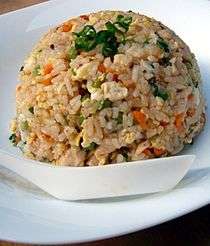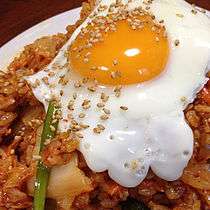Chahan (dish)
Chahan (Japanese: チャーハン/炒飯, Hepburn: chāhan), also known as Yakimeshi (Japanese: 焼飯), is a Japanese fried rice dish prepared with rice as a primary ingredient and myriad additional ingredients and seasonings. The dish is typically fried, and can be cooked in a wok. Chahan may have originated in the 1860s from Chinese immigrants arriving at the port of Kobe. Chahan is a staple food in homes in Japan.[1] A variation of the dish is kimchi chahan. Some restaurants outside Japan serve the dish as a part of their fare.
 | |
| Alternative names | チャーハン/炒飯 |
|---|---|
| Associated national cuisine | Japan |
| Created by | Chinese immigrants |
| Invented | 1860s |
| Main ingredients | Fried rice |
| Variations | Kimchi chahan |


History
Chahan may have originated from Chinese immigrants who arrived at the port of Kobe, Japan in the 1860s. In Chinese, fried rice is called chǎofàn (炒飯); these same Chinese characters have a Japanese reading of Chāhan.[2]
Preparation
Chahan is a Japanese fried rice dish that is typically fried, and can be cooked by stir frying it in a wok.[3][1][3] Rice is used as a primary ingredient, and myriad additional ingredients can be used, such as vegetables, onion, garlic, edible mushrooms such as shiitake, tofu, pork, pork belly, seafoods such as crab meat, roe, salmon, shrimp and octopus, scrambled egg, ground beef and chicken broth, among others.[1][4][5][6][7][8] Pre-cooked rice is typically used, and leftover rice is sometimes used.[1][2] Oils such as canola oil, sesame oil and sunflower oil are used to fry the dish.[1][7] The dish can be seasoned with soy sauce, oyster sauce, sesame oil, salt, pepper and katsuobushi, a dried and flaked tuna product.[7][8] Shiso, an Asian culinary herb, may also be used to flavor chahan.[9] Nori, a dried edible seaweed product, can be used as a garnish.[9]
The use of a hot wok for frying and cooking chahan quickly can prevent the rice from sticking to the pan, and using warm rice also prevents pan sticking.[2] The use of dried cooked rice, which can be accomplished by refrigerating it, is also conducive toward enhancing the cooking process.[1][9]
Variations
Kimchi chahan is prepared with kimchi as a primary ingredient, and can be prepared as a mild or spicy dish.[3]
Abroad
Some restaurants in other countries purvey chahan as part of their fare, such as in the Philippines and United States.[10][11]
See also
- Japanese cuisine
- List of fried rice dishes
- List of Japanese dishes
- List of rice dishes

References
- Samuels, D.; Robbins, H. (2013). My Japanese Table: A Lifetime of Cooking with Friends and Family. Tuttle Publishing. p. pt272–273. ISBN 978-1-4629-0638-3.
- Ono, T.; Salat, H. (2013). Japanese Soul Cooking: Ramen, Tonkatsu, Tempura, and More from the Streets and Kitchens of Tokyo and Beyond. Potter/TenSpeed/Harmony. pp. 397–398. ISBN 978-1-60774-353-8.
- Sakamoto, T.; Ltd, M.C.I.P. (2013). Cook Japanese with Tamako: Hearty Meals for the Whole Family. Marshall Cavendish International (Asia) Private Limited. pp. 32–33. ISBN 978-981-4516-87-7.
- Hachisu, N.S.; Miura, K. (2012). Japanese Farm Food. Andrews McMeel Publishing. p. 152. ISBN 978-1-4494-1829-8.
- Stallings, D.; Butler, S.E. (2011). Fodor's Japan. Fodor's Japan. Fodor's. p. 834. ISBN 978-0-307-48049-1.
- "IN PHOTOS: Niu by Vikings debuts 9 new dishes for a limited time". Rappler. October 17, 2015. Retrieved April 25, 2016.
- "Receita de tako chahan: arroz frito com polvo e cogumelo shitake". Mundo-Nipo (in Portuguese). September 14, 2015. Retrieved April 25, 2016.
- "Receita de ninniku chahan: arroz frito com alho, shissô e katsuobushi". Mundo-Nipo (in Portuguese). July 15, 2015. Retrieved April 25, 2016.
- "Garlic Fried Rice (Chahan)". The Washington Post. April 22, 2016. Retrieved April 25, 2016.
- "Heaven in bowl of ramen". Sun.Star Cebu. April 8, 2016. Retrieved April 25, 2016.
- "Plate Lab: Izakaya Seki's garlic fried rice is a bowl of late-night comfort". The Washington Post. December 18, 2014. Retrieved April 25, 2016.
External links
| Wikimedia Commons has media related to Chahan. |